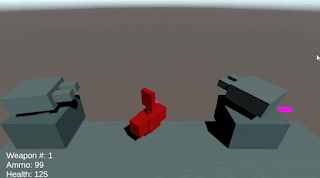I started sprint 2 by working on the broadside cannons. Getting them to fire at the appropriate angles wasn’t too much trouble, but this did require some (anticipated) improvements to the weapon system.
I wrote each weapon its own script using a base abstract class. Each weapon is separately attached to the player’s arsenal, and the existing weapon switch controls will select the appropriate weapon script. This lets me use the same set of controls to give each weapon a unique set of functionality, while keeping each one modular and self-contained.
This gif shows off just about everything I got working this sprint, which was a lot! It all comes together seamlessly, but there are a ton of little moving parts I had to get working.
I started by making sure the player lasers could damage objects. Then, I set them up with healthbars and flashing when they get hit. Next I made sure the turrets could rotate to face the player. The easiest way to do this would have been to just use Unity’s LookAt() function, but, anticipating what the future turrets are going to need, I wanted to make them have to turn gradually to face the player.
So instead I set up a spherical linear interpolation function. For the projectiles, I had to additionally incorporate some trigonometric functions to get their angle to be correct. The awesome end result is that the cannon turrets track the player pretty well, but not perfectly, and are susceptible to missing when the player moves and turns quickly.
And once I got the cannon battlements firing, I set up a health bar for the player as well, and all the appropriate functions (damage flashing too). Standard stuff.
There were a whole host of other additions I made, such as the sprinting mechanics shown in this gif. It runs on a simple toggle system, but makes movement and combat quite a bit more interesting—it’s a lot harder to aim when you’re speeding up, which means it’s a bit of a tradeoff.
I also put together a pickup system that lets the player collect health and ammunition canisters. This is pretty standard from projects I’d worked on in the past, where there’s a base pickup class with a pickup function that can be customized to give the player whatever statistic is requested.
What did require more thought was getting them to spawn in an evenly distributed pattern.
This segment then got implemented for the space stations, which explode when their associated battlements are destroyed. Circles are tricky, but as always, some math can get it working. To let designers set this up however they want, the space stations have a publicly accessible list designers can place the matching battlements into. There’s a similar list for the pool of loot dropped.
Finally, I put together our first prototype by designing and implementing a miniature level that demonstrates all the mechanics created thus far. Our playtesters can try out flying the ship, firing the cannons, getting into fights with battlements, and collecting items.
Overall I’m super proud of the work I did this sprint, it puts our team in an amazing place to keep making progress on the game. I got a bunch of little systems all working together to create a cohesive combat system for the game. It looks obvious now that it’s put together, but even just this most basic enemy required both sets of projectiles, healthbars, aiming, and feedback. That’s why a lot of the code I wrote, such as the weapon system, is immensely scalable, meaning that future features will be even easier to implement.











